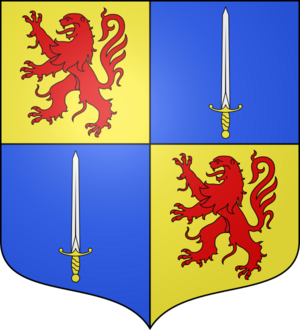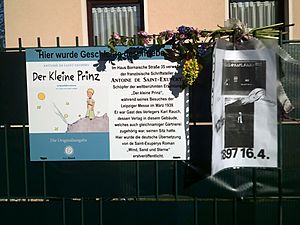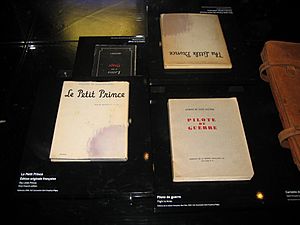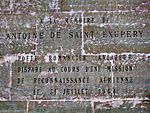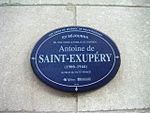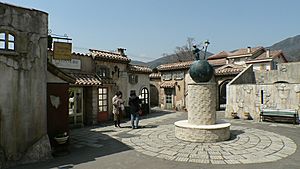Antoine de Saint-Exupéry facts for kids
Quick facts for kids
Antoine de Saint-Exupéry
|
|
|---|---|

Saint-Exupéry in Toulouse, 1933
|
|
| Born | Antoine Marie Jean-Baptiste Roger de Saint-Exupéry 29 June 1900 Lyon, France |
| Died | Presumed 31 July 1944 (aged 44) Mediterranean Sea, off Marseille, Occupied France |
| Occupation | Aviator, writer |
| Education | Villa St. Jean International School |
| Genre | Autobiography, belles-lettres, essays, children's literature |
| Notable awards |
|
| Spouse |
Consuelo Suncín de Sandoval
(m. 1931) |
| Signature | |
| Military career | |
| Allegiance | |
| Service/ |
|
| Years of service |
|
| Rank | Commander |
| Unit |
|
| Battles/wars | World War II |
| Awards |
|
Antoine Marie Jean-Baptiste Roger, comte de Saint-Exupéry, known as Antoine de Saint-Exupéry (born June 29, 1900 – died July 31, 1944), was a famous French writer, poet, and brave pilot. He won many top literary awards in France and the United States. He is best known for his beloved story The Little Prince (Le Petit Prince). He also wrote amazing books about flying, like Wind, Sand and Stars and Night Flight.
Before World War II, Saint-Exupéry was a successful pilot. He flew airmail routes across Europe, Africa, and South America. When the war started, he joined the French Air Force. He flew important missions until France made a peace agreement with Germany in 1940.
After leaving the French Air Force, he went to the United States. He hoped to convince the U.S. government to join the war against Nazi Germany. He spent 28 months in America, where he wrote some of his most famous books. Later, he joined the Free French Air Force in North Africa. He was older than most pilots and not in perfect health, but he wanted to help.
Antoine de Saint-Exupéry disappeared on July 31, 1944. He was on a mission over the Mediterranean Sea near Corsica. The wreckage of his plane was found in 2000 near Marseille. However, no one knows for sure what caused his plane to crash.
Saint-Exupéry was already famous as a pilot before the war. After he died, his books made him a national hero in France. The Little Prince has been translated into over 300 languages! His book Terre des hommes (Wind, Sand and Stars) even inspired the name of an international group that helps people. His hometown of Lyon named its main airport and train station after him.
Early Life and Flying Adventures

Antoine de Saint-Exupéry was born in Lyon, France, into an old, noble family. He was the third of five children. His father passed away when Antoine was only four years old. This made things harder for his family, who became "impoverished aristocrats."
Antoine had three sisters and a younger brother named François. François, his closest friend, died at age 15 from a fever. Antoine was with him at the end. This sad moment later inspired a very important part of The Little Prince. After his brother's death, Antoine, then 17, felt he had to protect his mother and sisters.
Antoine tried to join the Naval Academy but didn't pass his final exams twice. He then studied architecture for a short time but didn't finish. He took on many different small jobs. In 1921, he joined the military as a soldier. While there, he started taking private flying lessons. The next year, he was able to transfer to the French Air Force. He earned his pilot's wings in Casablanca, Morocco.
After his first plane crash, Antoine's fiancée's family worried about his safety. He left the air force for a while and tried office jobs, but they didn't work out.
By 1926, Saint-Exupéry was flying again. He became one of the first pilots to fly international airmail. Back then, planes had very few instruments. He flew for a company called Aéropostale between Toulouse and Dakar. He also managed an airfield in the Sahara desert. His job included rescuing pilots who crashed and were taken by local tribes. This dangerous work earned him his first Légion d'honneur award from the French government.
In 1929, Saint-Exupéry moved to Argentina. He became the director of the Aeroposta Argentina airline. He explored new air routes across South America. He even flew mail and searched for lost pilots himself sometimes. This part of his life is shown in the IMAX film Wings of Courage.
Becoming a Famous Writer

Saint-Exupéry's first short story, L'Aviateur (The Aviator), was published in 1926. In 1929, his first book, Courrier Sud (Southern Mail), came out. This marked the beginning of his career as both a pilot and a writer.
His book Vol de nuit (Night Flight), published in 1931, made him a rising star in the literary world. It was his first major work to become widely popular and won the prix Femina. The story was based on his own experiences as a mail pilot and airline director in Argentina. That same year, Saint-Exupéry married Consuelo Suncin. She was a writer and artist from El Salvador. Their marriage was often difficult, but she was also a big inspiration for him.
Saint-Exupéry continued to write until 1943. He then left the United States to join American troops in North Africa for World War II.
Surviving a Desert Crash

On December 30, 1935, Saint-Exupéry and his mechanic, André Prévot, crashed in the Libyan desert. They were trying to break a speed record in an air race from Paris to Saigon. The crash happened after nearly 20 hours of flying.
Both men amazingly survived the crash. But they faced extreme dehydration in the desert heat. Their maps were not helpful, and they had no idea where they were. They only had a few grapes, two oranges, a small cake, some coffee, and a little wine. They also had a small amount of medicine.
They had only enough liquids for one day. They started seeing things that weren't there and hearing sounds. By the second and third day, they were so dehydrated they stopped sweating. On the fourth day, a Bedouin on a camel found them. The Bedouin gave them a special rehydration treatment that saved their lives. This close call with death became a big part of his 1939 book, Wind, Sand and Stars. His famous story The Little Prince, which starts with a pilot stranded in the desert, was also inspired by this experience.
Life in America and The Little Prince

After Germany invaded France in 1940, Saint-Exupéry flew reconnaissance missions. When France made a peace agreement with Germany, he went to North America. He arrived in New York City at the end of 1940. He wanted to convince the U.S. to join the war against Nazi Germany. In 1941, he received his National Book Award for Wind, Sand and Stars, which he had won a year earlier.
Between 1941 and 1943, the Saint-Exupérys lived in New York City. They also stayed in Quebec City, Canada, for several weeks in 1942. There, they met a young boy named Thomas, who may have inspired the character of the Little Prince.
It was in the United States that Saint-Exupéry started using the hyphen in his last name. He was tired of Americans calling him "Mr. Exupéry." During this time, he wrote Pilote de guerre (Flight to Arras) and Lettre à un otage (Letter to a Hostage). The letter was for the 40 million French people living under Nazi rule.
After his time in Quebec, a friend suggested he write a children's book. She hoped it would help calm his nerves. Saint-Exupéry wrote and illustrated The Little Prince in New York City in 1942. It was first published in early 1943 in the United States, in both English and French. It was only published in France after the war, because his books had been banned by the government that worked with the Nazis.
Returning to War
In April 1943, after 27 months in North America, Saint-Exupéry went to Algiers. He wanted to fly with the Free French Air Force and fight with the Allies. He was 43 years old, much older than most pilots in combat units. He had many old injuries from his previous crashes. He couldn't even turn his head easily to check for enemy planes.
He was assigned to his old unit, flying P-38 Lightnings. These planes were more complex than what he was used to. He had to train for seven weeks. After crashing a P-38 on his second mission, he was grounded for eight months. But he was allowed to fly again after General Ira C. Eaker personally stepped in.
When he started flying again, he also went back to his habit of reading and writing while flying. He would sometimes read novels until just before takeoff. Once, he even circled the airport for an hour after returning from a flight just to finish a book! He often carried a notebook with him on his long, lonely flights. Many of his thoughtful writings came from these times.
His Disappearance
Before he returned to flying, the French government that worked with the Nazis (the Vichy Regime) tried to claim Saint-Exupéry as one of their own. This was a shock to him. Later, French General Charles de Gaulle (who Saint-Exupéry didn't admire much) suggested that the author was supporting Germany. Saint-Exupéry's health, both physical and mental, was getting worse. He was sometimes depressed, and there was talk of stopping him from flying.
Saint-Exupéry's last mission was to gather information on German troop movements near the Rhone Valley. This was before the Allied invasion of southern France. On July 31, 1944, he took off from an airbase on Corsica in an unarmed P-38. It was his ninth mission. He never returned, and no one knew what happened to him. News of his disappearance quickly spread around the world.
Finding the Wreckage
In September 1998, a fisherman found a silver identity bracelet east of Riou Island, near Marseille. It had Saint-Exupéry's name, his wife Consuelo's name, and his American publisher's name on it. The bracelet was attached to a piece of fabric, probably from his flight suit. This discovery was very emotional in France, where Saint-Exupéry was a national hero. Some people doubted it was real because it was found far from his planned flight path.
In May 2000, a diver found parts of a Lockheed P-38 Lightning plane underwater near Marseille. This was close to where the bracelet was found. This discovery excited the whole country. France had been searching for his plane and wondering about his fate for decades. After a two-year delay, the plane's parts were brought up in October 2003.
In 2004, French officials confirmed that the wreckage was indeed from Saint-Exupéry's plane. No marks from gunfire were found on the small pieces recovered. However, this doesn't mean he wasn't shot down, as only a small part of the plane was found. In June 2004, the parts were given to the Air and Space Museum in Paris, where Saint-Exupéry's life is celebrated.
Ideas About His Disappearance
Over the years, many people have wondered what happened to Saint-Exupéry.
In 2008, a French journalist talked to former German Luftwaffe pilots who flew in the Marseille area. One pilot, Horst Rippert, said he might have shot down Saint-Exupéry's plane. Rippert claimed he reported the kill over his radio, but there are no records to prove this. Rippert was a big fan of Saint-Exupéry's books. He said he became sure he was responsible when he learned where the wreckage was found.
However, Rippert's story was met with doubt. His fellow German pilots were surprised he kept it secret for 64 years. Also, many German war records were lost. So, there's no direct proof to confirm his claim. The cause of Saint-Exupéry's death is still unknown, and Rippert's story is just one idea among many.
His Amazing Books
Many of Saint-Exupéry's books were inspired by his experiences as a pilot. His most famous book is The Little Prince. It's a poetic story he illustrated himself with watercolors. In the story, a pilot crashes in the desert and meets a young prince from a tiny asteroid.
The Little Prince was partly based on his own desert crash in Libya. He and his mechanic were stranded for four days, almost dying. They were saved when a Bedouin gave them water. Saint-Exupéry later wrote in Wind, Sand and Stars that the Bedouin showed them "charity and generosity" by bringing water. The Little Prince is a deep story that also gently criticizes the strange ways of the adult world. One person who wrote about his life said, "Rarely have an author and a character been so closely linked as Antoine de Saint-Exupéry and his Little Prince."
Here are some of Saint-Exupéry's important books:
- L'Aviateur (1926) (The Aviator)
- Courrier sud (1929) (Southern Mail) – later made into a French movie.
- Vol de nuit (1931) (Night Flight) – won the prix Femina and was made into movies.
- Terre des hommes (1939) – won the Grand Prix du roman de l'Académie française.
- Wind, Sand and Stars (English version published at the same time) – won the U.S. National Book Award.
- Pilote de guerre (1942) (English title: Flight to Arras).
- Le petit prince (1943) (The Little Prince), published in France after his death – translated into over 250 languages and one of the best-selling books in the world. It has been made into many movies and TV shows.
- Lettre à un otage (1944) (Letter to a Hostage, published in English after his death).
Books Published After He Died
- Citadelle (1948) (English title: The Wisdom of the Sands).
- Carnets (1953) (his notebooks).
- Lettres à sa mère (1955) (letters to his mother).
- Un sens à la vie (1956) (A Sense of Life).
- Écrits de guerre, 1939–1944 (1982) (Wartime Writings, 1939–1944).
Other Writings
Saint-Exupéry also worked as a journalist and publicist. He wrote articles for newspapers about events in places like Indochina, the Soviet Union, and the Spanish Civil War.
During World War II, he wrote "An Open Letter to Frenchmen Everywhere." This letter tried to unite French people against Nazi rule. It was published in The New York Times Magazine in 1942.
Censorship and Bans
His book Pilote de guerre (Flight To Arras) was about the German invasion of France. It was censored slightly when it first came out in France. Later, the Vichy government, which worked with the Nazis, banned the book. They didn't like that it praised a Jewish squadron colleague, Captain Jean Israël. They attacked Saint-Exupéry for defending Jewish people. This led to his books being banned in France.
Strangely, his books were also banned in French territories controlled by Free France. This was because Saint-Exupéry didn't publicly support General Charles de Gaulle, the leader of the Free French Forces. Saint-Exupéry worried that de Gaulle might become a dictator after the war. In response, de Gaulle suggested that Saint-Exupéry supported Germany. So, his writings were banned by both sides!
Because Saint-Exupéry died during the war, the French government gave his estate a special status: Mort pour la France (Died for France). This means the copyright on his works will last 30 years longer than usual in France.
Honours and Legacy
- Images of remembrance
-
Commemorative inscription in the Panthéon of Paris.
-
Portrait and images from The Little Prince on a 50-franc banknote.
-
Historical marker where the Saint-Exupérys resided in Quebec.
- Saint-Exupéry is honored with an inscription in the Panthéon in Paris. This is a special place for France's historical heroes. Even though his body was never found, his name was added in 1967. The inscription says: "To the memory of Antoine de Saint Exupery, poet, novelist, aviator, missing during an aerial reconnaissance mission, 31 July 1944." He also received the Legion of Honour and the Croix de Guerre for his bravery.
- From 1993 until the euro currency was introduced, Saint-Exupéry's picture and drawings from The Little Prince were on France's 50-franc banknote. France also made a special 100-franc coin with his image.
- In 2000, on his 100th birthday, the airport in his hometown of Lyon was renamed Lyon-Saint Exupéry Airport. The high-speed train station there was also renamed Gare de Lyon Saint-Exupéry. There's also a statue of him in Lyon, showing him seated with the Little Prince standing behind him.
Museums and Exhibits

Museums and special exhibits about Saint-Exupéry and The Little Prince have been created around the world. You can find them in France, South Korea, Japan, Morocco, Brazil, the United States, and Canada.
- The French Air and Space Museum in Paris has a permanent exhibit called Espace Saint Exupéry. It shows his life as a pioneering airmail pilot, writer, and military pilot. It includes photos, drawings, letters, his original notebooks, and even parts of his plane found in the Mediterranean Sea.
- In Tarfaya, Morocco, where Saint-Exupéry was an airmail pilot, there's an Antoine de Saint-Exupery Museum. It honors him and the Aéropostale company.
- In South Korea and Japan, there are theme village museums dedicated to The Little Prince.
- In 2009, an exhibition in São Paulo, Brazil, covered over 10,000 square meters. It showed Saint-Exupéry's life, The Little Prince, and their ideas. It even had a full-size replica of his crashed plane from his desert accident.
- In 2014, New York City's Morgan Library & Museum had a major exhibition called The Little Prince: A New York Story. It showed many of Saint-Exupéry's original manuscript pages and watercolor paintings.
International Tributes
- Saint-Exupéry's 1939 book Terre des hommes (Wind, Sand and Stars) was chosen as the main theme for the 1967 International and Universal Exposition in Montreal, Canada. The theme was "Terre des Hommes–Man and His World."
- An asteroid, 2578 Saint-Exupéry, was named after him. Another asteroid, 46610 Besixdouze, was named after Asteroid B-612 from The Little Prince. The B612 Foundation, which works to protect Earth from asteroids, is also named in tribute to his famous story.
- Stamps honoring Saint-Exupéry have been printed in at least 25 countries. France, French West Africa, and Israel have all issued stamps featuring him or The Little Prince.
- In Argentina and Brazil, where he helped start the airmail airline Aeroposta Argentina:
- The Aguja Saint Exupery is a mountain peak in Patagonia, Argentina, named in his honor.
- The San Antonio Oeste airport in Argentina is named Aerodromo Saint Exupery.
- Several schools in Argentina are also named after him.
Institutions and Schools
- In 1960, the humanitarian organization Terre des hommes was founded in Switzerland. It was named after Saint-Exupéry's book Terre des hommes. This group helps young people around the world.
- In 2009, the Antoine de Saint-Exupéry Youth Foundation (FASEJ) was started in Paris. It aims to promote education, art, culture, health, and sports for young people, especially those who are less fortunate.
- Many schools, colleges, and technical schools in France, Europe, Quebec, and South America are named after Saint-Exupéry. This includes schools in Rwanda and Senegal.
Other Tributes
- One of the French Air Force squadrons Saint-Exupéry flew with, the GR I/33, adopted the image of the Little Prince as part of its squadron symbol on its fighter jets.
- Google celebrated Saint-Exupéry's 110th birthday with a special logo showing the Little Prince being carried by birds.
- Many streets and places around the world are named after him.
- The shipping company CMA CGM named its new flagship container ship, the Antoine de Saint-Exupéry, to honor his achievements.
See Also
 In Spanish: Antoine de Saint-Exupéry para niños
In Spanish: Antoine de Saint-Exupéry para niños
- List of people who disappeared
General
- Consuelo de Saint Exupéry, wife of Saint-Exupéry
- Indexed listing of Wikipedia's Saint-Exupéry articles
Literary works in English
- The Aviator
- Southern mail
- Night Flight
- Wind, Sand and Stars
- Flight to Arras
- The Little Prince
- A Sense of Life
Media and popular culture
- List of The Little Prince adaptations
- Saint-Ex, a 1997 British biopic


